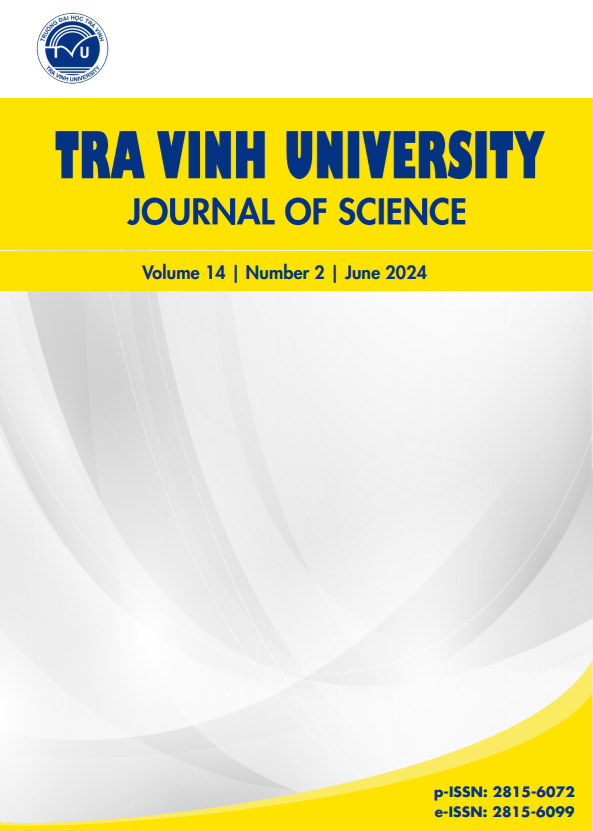CHARACTERIZATION OF THE CHLOROPLAST GENOME OF AQUILARIA CRASSNA PIERRE EX LECOMTE DISTRIBUTED IN VIETNAM USING LONG-READ DATA (OXFORD NANOPORE TECHNOLOGIES)
Abstract
Aquilaria crassna Pierre ex Lecomte is a critically endangered species that is famous for its fragrance compounds for perfume and incense production. In this study, the complete chloroplast genome of A. crassna was sequenced using a long-read sequencing method of Oxford Nanopore Technologies. The complete chloroplast genome of A. crassna was 174,766 bp in length, which comprised a large single copy region of 87,231 bp, a small single copy region of 3,343 bp, and two inverted repeat regions of 42,096 bp. This genome contained 95 protein-coding genes, 38 transfer RNA genes, and eight ribosomal RNA genes. The analysis of
small single repeats revealed 39 mononucleotide and seven dinucleotide repeats, which are located mainly in non-coding regions. Comparative genomic analysis exhibited high conservation of the chloroplast genome within the Aquilaria genus regarding gene content, gene order, and genomic structure. This study provides useful genomic data for further studies examining the genetic population, genetic conservation, molecular markers, and phylogeny of Aquilaria crassna and related species within Thymelaeaceae.
-- PDF Article: https://drive.google.com/file/d/16MoCLRJqgLJ61N9S3yG6uOyHrJeVMeur/view?usp=sharing
Downloads
References
https://powo.science.kew.org
/taxon/urn:lsid:ipni.org:names:331359-2 [Accessed
1st January 2024].
[2] Shivanand P, Arbie NF, Krishnamoorthy S, Ahmad N. Agarwood—The fragrant molecules of
a wounded tree. Molecules. 2022;27(11): 3386.
https://doi.org/10.3390/molecules27113386.
[3] Toan TQ, Dinh TTT, Tran TT, Hoang TB, Pham QL,
Nguyen QC, et al. Chemical compositions of essential oil of agarwood (Aquilaria crassna) harvested in
Phu Quoc island, Vietnam. Engineering Chemistry.
2023;4: 51–57. https://doi.org/10.4028/p-oHM1mQ.
[4] Huy BL, Xuan HN, Tan PN, Thanh LT, Minh
TL. Study about agarwood oil (Aquilaria crassna
Pierre) in Phu Quoc Island National Park, Vietnam. Research Aspects in Biological Science Vol.
1. Book Publisher International; 2022. p. 1–38.
https://doi.org/10.9734/bpi/rabs/v1/1795B.
[5] Jok VA, Che Radzi N, Ku Hamid KH. A review:
pharmacological properties of Aquilaria spp.
Advanced Materials Research. 2015;1113: 193–197.
https://doi.org/10.4028/www.scientific.net/AMR.1113.193.
[6] Wongwad E, Pingyod C, Saesong T, Waranuch
N, Wisuitiprot W, Sritularak B, et al. Assessment of the bioactive components, antioxidant,
antiglycation and anti-inflammatory properties of
Aquilaria crassna Pierre ex Lecomte leaves. Industrial Crops and Products. 2019;138: 111448.
https://doi.org/10.1016/j.indcrop.2019.06.011.
[7] Dobrogojski J, Adamiec M, Lucinski R. The chloro- ´
plast genome: a review. Acta Physiologiae Plantarum.
2020;42(6): 98. https://doi.org/10.1007/s11738-020-
03089-x.
[8] Yang T, Sahu SK, Yang L, Liu Y, Mu W, Liu
X, et al. Comparative analyses of 3,654 plastid genomes unravel insights into evolutionary dynamics and phylogenetic discordance of green
plants. Frontiers in Plant Science. 2022;13: 808156.
https://doi.org/10.3389/fpls.2022.808156.
[9] Dong W, Liu J, Yu J, Wang L, Zhou S.
Highly variable chloroplast markers for evaluating plant phylogeny at low taxonomic levels and
for dna barcoding. PLoS One. 2012;7(4): e35071.
https://doi.org/10.1371/journal.pone.0035071.
[10] Hishamuddin MS, Lee SY, Ng WL, Ramlee SI,
Lamasudin DU, Mohamed R. Comparison of eight
complete chloroplast genomes of the endangered
Aquilaria tree species (Thymelaeaceae) and their phylogenetic relationships. Scientific Reports. 2020;10:
13034. https://doi.org/10.1038/s41598-020-70030-0.
[11] Deng X, Jiang Z, Jiang Q, Guo W, Li Y,
Zhang X. Characterization of the complete
chloroplast genome of Aquilaria sinensis,
an endangered agarwood-producing tree.
Mitochondrial DNA Part B. 2020;5(1): 422–423.
https://doi.org/10.1080/23802359.2019.1703593.
[12] Li GD, Rao PY, Guo JL, Zhang YH. The complete chloroplast genome of a critically endangered
agarwood tree, Aquilaria crassna (Thymelaeaceae).
Mitochondrial DNA Part B. 2019;4(1): 1810–1811.
https://doi.org/10.1080/23802359.2019.1613200.
[13] Wang Y, Zhan DF, Jia X, Mei WL, Dai HF, Chen
XT, et al. Complete chloroplast genome sequence of
Aquilaria sinensis (Lour.) gilg and evolution analysis
within the malvales order. Frontiers in Plant Science.
2016;7: 280. https://doi.org/10.3389/fpls.2016.00280.
[14] Wick RR, Judd LM, Holt KE. Performance
of neural network basecalling tools for Oxford
Nanopore sequencing. Genome Biology. 2019;20:
129. https://doi.org/10.1186/s13059-019-1727-y.
[15] Vaser R, Siki ˇ c M. Time- and memory- ´
efficient genome assembly with Raven. Nature
Computational Science. 2021;1(5): 332–336.
https://doi.org/10.1038/s43588-021-00073-4.
[16] Tillich M, Lehwark P, Pellizzer T, Ulbricht-Jones
ES, Fischer A, Bock R, et al. GeSeq – versatile
and accurate annotation of organelle genomes.
Nucleic Acids Research. 2017;45: W6–W11.
https://doi.org/10.1093/nar/gkx391.
[17] Greiner S, Lehwark P, Bock R. OrganellarGenomeDRAW (OGDRAW) version 1.3.1: expanded
toolkit for the graphical visualization of organellar
genomes. Nucleic Acids Research. 2019;47: W59–64.
https://doi.org/10.1093/nar/gkz238.
[18] Kraemer L, Beszteri B, Gabler-Schwarz S, Held ¨
C, Leese F, Mayer C, et al. STAMP: Extensions to the STADEN sequence analysis package
for high throughput interactive microsatellite marker
design. BMC Bioinformatics. 2009;10: 233–241.
https://doi.org/10.1186/1471-2105-10-41.
[19] Hishamuddin M, Samsuddin A, Mohamed R. Mining and analysis of chloroplast simple sequence
repeats (SSRs) from eight species of Aquilaria.
Turkish Journal of Botany. 2021;46(1): 26–36.
https://doi.org/10.3906/bot-2108-61.
[20] Tan F, Li W, Feng H, Huang Y, Banerjee AK. Interspecific variation and phylogenetic relationship between mangrove and non-mangrove species of a same
family (Meliaceae)—insights from comparative analysis of complete chloroplast genome. PeerJ. 2023;11:
e15527. https://doi.org/10.7717/peerj.15527.
[21] Peng JY, Zhang XS, Zhang DG, Wang Y, Deng
T, Huang XH, et al. Newly reported chloroplast genome of Sinosenecio albonervius Y. Liu
& QE Yang and comparative analyses with other
Sinosenecio species. BMC Genomics. 2022;23(1):
639. https://doi.org/10.1186/s12864-022-08872-3.
[22] Zhang W, Zhang Z, Liu B, Chen J, Zhao Y, Huang
Y. Comparative analysis of 17 complete chloroplast
genomes reveals intraspecific variation and relationships among Pseudostellaria heterophylla (Miq.) Pax
populations. Frontiers in Plant Science. 2023;14:
1163325. https://doi.org/10.3389/fpls.2023.1163325.
[23] Mu Z, Zhang Y, Zhang B, Cheng Y, Shang F, Wang
H. Intraspecific chloroplast genome variation and
domestication origins of major cultivars of Styphnolobium japonicum. Genes (Basel). 2023;14(6): 1156.
https://doi.org/10.3390/genes14061156.









